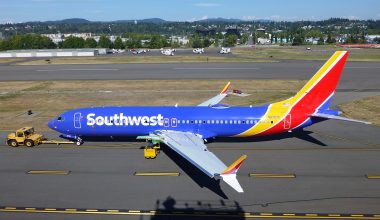The airline industry is a critical component of the global economy. While disruptions may interrupt the industry’s steady growth, nothing seems to prevent an overall upwardly moving-trend. In 2019, 4.5 billion international passengers took flight on 38.3 million departing planes, the result of a steady climb that began in the early 2000s.
Airline operations rely on a complex network of professionals and technologies. Analog technology is no longer entirely up to the task, and the industry’s digital transformation is marching forward rapidly. Increasingly, companies must incorporate intelligent digital technology to maintain safe and efficient operations and improve customer experiences.

The Importance of Digitalization in Aviation Industry
Each link in the aviation chain of operations is critical to the industry’s safety and efficiency. Human error in the airline industry can have serious consequences. Human factors contributed to 80% of airplane maintenance issues, leading to flight delays, craft damage, injuries and plane accidents, and crashes. Aviation digital transformation can reduce the risk of human errors, cutting industry operational costs and potentially saving lives.
Ultimately, digitalization improves the customer experience. The airline industry depends on customer safety and satisfaction. Improving efficiency and safety at all levels can help companies improve their reputations, leading to higher customer acquisition and retention rates.
How Does Digitalization Improve Operational Efficiency?
Operational efficiency is critical in aviation, given that delays result in significant financial losses. In 2019, delays cost the U.S. airline industry an estimated $33 billion. Digitalized technology can be incorporated at every level of the industry, including the following:
- Flight training process
- Airline business process
- Maintenance operations
- Ground operations
- Cockpit and cabin procedures
Digitalization improves the rate of and access to data, often providing valuable real-time information to industry professionals and passengers.
Training
Digital technology improves training efficiency for training programs, airlines, pilots and other workers. Digitizing training manuals ensure access and reduce paper manuals’ costs and burdens. Online manuals are also easier to update, with the potential for instantaneous changes wherever the manuals are deployed.

Online modules and tests make it easy to keep track of trainee progress and identify at-risk employees. Additional learning materials and training sessions can be added so those who require more in-depth or corrective lessons have immediate access.
Business Processes
The aviation digitalization transformation is improving business process efficiency from online timekeeping to streamlined communications. Digital technology reduces the time and space needed for completing, organizing and maintaining documents and files, including personnel records, flight logs and performance reports.
Also read: Silver Jubilee of Star Alliance-the world’s largest global airline alliance
Maintenance
Implementing digital technology in maintenance operations allows for more efficient tracking of maintenance and repair schedules. Some companies are using technology to predict when an aircraft will need maintenance, leading to more effective use of time and reducing the risks of malfunctioning parts.

Ground Operations
Ground operations are an airport hub, linking multiple aspects of a plane and a customer’s journey. From safety checks to baggage transport, ground crew responsibilities are a critical cog in the wheel, with a high potential for errors and delays. Digital technology can place everything ground crews need in the palm of their hands, improving coordination and communication and creating a much smoother process.
Cockpit and Cabin Procedures
Cockpit and cabin procedures are the culminating steps in a long chain of airline operations and management processes. Digitalization provides more efficient and effective communication between the cockpit, cabin crewmembers and ground crews. Additionally, devices allow instantaneous data exchange, putting more eyes on critical information.
How Does Digitalization Improve Airline Safety?
Airline safety begins at the manufacturing level, and digitization is changing how manufacturers do their jobs. The current technology allows companies to digitally test parts and equipment using a digital twin that looks like the real thing and behaves and responds like it. This breakthrough digital development significantly improves safety and performance before parts and equipment leave the plant.
Airline digital transformation can also improve plane and flight safety. More efficient maintenance tracking and scheduling processes make aircraft less likely to have critical issues that lead to emergency situations. In-flight data sharing and communication may improve passenger and crew safety through real-time updates and alerts. Cockpit crews who often rely on communications from other pilots for changes in weather conditions can receive digital updates that help them avoid dangerous flight conditions and arrange alternate routes when needed.
The Next Level of Airline Digital Transformation
Automated and intelligent workflow technology takes the digitalization of airline operations to the next level. Automation further integrates functions and improves efficiency and safety throughout the industry. Data analysis and procedural checks are automated, reducing computation time and improving accuracy. Automated alert systems let personnel know about an issue before it develops into an emergency.
Intelligent technology is responsive and adaptive, further reducing the human-involved steps that can bog down or introduce errors in any process. While robots are entering the picture, most of the digital technology in the airline industry still revolves around improving people-centered processes.
The Benefits of Software for Airline Digital Solutions
Airline management software improves airline operations and management with document flow automation, mobile forms with secure digital signing, approval workflows and advanced reporting capabilities. It is important to choose platforms that comply with ISO 27001 information security management standards, so industry data and records are safe throughout storage, transmission, and retrieval processes.

Aviation software supports the aviation industry in the following ways:
- Digitizing logs for flights, maintenance, weight and balance worksheets and discrepancy reports and automating calculations
- Storing and sharing up-to-date flight manuals that adhere to the latest policy requirements
- Providing a communications platform to coordinate processes between cabin and ground crews
- Automating data control checks and alerts
- Improving training efficiency with digital learning manuals, comprehension checks, and automated scoring
Aviation companies are in the middle of rapid digitalization. Those who take steps to get ahead of the curve can increase their appeal to customers and boost their bottom lines.






